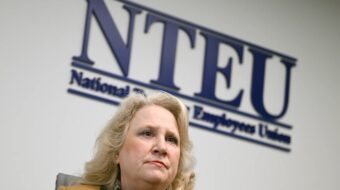
The nation faces a deepening political crisis and the 2018 mid-term elections can’t come fast enough.
The release of the new book, Fear, by Bob Woodward and the unprecedented New York Times op-ed penned by an anonymous senior Trump administration official illustrate the danger to democracy and looming constitutional crisis.
The total complicity of the GOP Congress, including ramrodding Brett Kavanaugh’s nomination to the U.S. Supreme Court by covering up his history as a right-wing political operative and abetting efforts to undermine the Mueller investigation, is compounding the danger.
The right-wing media apparatus is a propaganda arm of the White House and has helped Trump build a mass base in a parallel universe of lies, hate, fear and paranoia, with the potential to become a mass fascist base. Approximately 90 percent of GOP voters consistently support Trump regardless of what he does.
The deepening political crisis could prompt Trump and the GOP to undertake desperate measures to maintain their grip on power, including trampling on the constitution. Therefore, the struggle to defend democracy and democratic norms, no matter how fragile and limited, including the right to vote and the investigation into the burgeoning scandals surrounding Trump, is the central battle today.
The urgency of inflicting a sweeping defeat on Republicans in November has never been greater. It would lay the basis to block Trump’s agenda and defeat him and the GOP in 2020.
In place of GOP domination, it could open the path to a left-center governing coalition — a 21st-century Roosevelt-type administration. Such an administration could begin to implement a broad range of advanced reforms and create space for all kinds of movements to grow, including political independence and those that advocate an eco-socialist oriented path of development.
Building broadest opposition possible
Opposition to Trump and the GOP reflects a complex and many-layered alliance based in the historic resistance led by women, people of color, the LGBTQ community, the multi-racial working class and a broad range of democratic movements. It embraces a range of political tendencies from left, including socialists and communists, to even right of center. President Obama’s entrance into the fray offers a powerful new dimension.
Trump’s approval rating is down to 36 percent which means most Americans are potential voters against GOP candidates. This includes many who voted for Trump but now have second thoughts.
The opposition is also multi-class, including sections of corporate America who are temporary and unreliable allies and oppose Trump for their own reasons.
Every effort to grow the breadth of alliance and tactical flexibility needed to isolate Trump and defeat the GOP majority should be encouraged.
This includes welcoming splits in the GOP, and opposition by Republicans to any Trump policy for whatever reason. Every division and defection on the right should be taken advantage of even if the battle lines have shifted further to the right.
One example is the late Sen. John McCain, a contradictory figure who broadly supported Trump’s right-wing agenda. At the same time, McCain opposed Trump on key issues including immigration reform, Muslim ban, Obamacare repeal (who didn’t celebrate when he turned thumbs down?), denial of climate science, and attack on LGBTQ rights. McCain saw in Trump a singular danger, including of fascism, and detested him.
Shifting public opinion
The nation is seething. The unprecedented upsurge of protest and opposition against Trump and the GOP has its sights on the 2018 elections. While there are no guarantees of victory, all signs point to a massive voter turnout and a growing number of vulnerable Republican-held seats.
The base of Democratic Party voters is highly energized. Voter turnout in the 2018 primaries increased 78 percent over 2014 according to Pew Research, including in key swing states, a result of greater involvement, more contested primaries and many outstanding candidates.
This is a great sign for November amid calls for a presidential election-type turnout.
One of the narratives being pushed by the corporate media is the Democratic primaries boiled down to a battle between the “establishment” and the “insurgent” wings within the Democratic Party. Everything becomes a reprise of the Clinton versus Sanders primary fight.
However, I don’t think this captures the complexity of developments and the interplay of dynamic forces.
For sure, many want to remake the Democratic Party into a fighting organization and some groups are explicitly trying to elect socialist candidates. On the other side some entrenched forces in the Democratic Party leadership, a party dominated by corporate interests, feel threatened by the shifts in public opinion and energized base.
There is also a trend that dismisses the center forces, including in the Democratic Party leadership, on the grounds they are Neoliberal and no different from the right-wing. To defeat Trump, it is asserted, these forces must first be defeated or at least defeated in tandem.
This approach doesn’t fully appreciate the danger posed by Trump and the GOP, splits in the corporate ruling class and the need to take advantage of them or the breadth of alliances necessary to defeat them.
It is not a matter of going to war with the center, including the broad mainstream beyond the Democratic Party. It is a matter of engaging and uniting with the center to defeat the right and in the process helping the center to move and adapt to more advanced positions.
The political center, both in the Democratic Party and in the population at large, is changing and adjusting in response to events. Many Democratic Party leaders who embraced the so-called 3rd way or Democratic Leadership Council, have retreated from a range of previously held positions.
Most of the Democratic electorate, including center or moderate voters, has shifted to varying degrees depending on district and state. A wide spectrum of voters is responding to bold and ambitious solutions.
Positions considered left a year or two ago are mainstream Democratic positions today. For example, Medicare for All, $15 per hour minimum wage, free college tuition, common sense gun control, legalization of marijuana, ending mass incarceration, etc.
According to Jared Bernstein, the goals of the so-called insurgents “are directionally shared by moderates.” Most proposals by left and progressive voters and moderate or mainstream Democrats voters move in a similar direction. The debate is how far to go and the best way to get there.
A new Gallup poll showed 57 percent of Democratic voters have a positive attitude toward socialism (however they define it). Forty-seven percent view capitalism negatively, an increase of nearly 10 percent since 2016. African Americans and youth show the highest positive attitude toward socialism.
This shift is the basis upon which socialists are winning elections, including Alexandria Ocasio-Cortez in New York and other members of Democratic Socialists of America (DSA), in deep blue districts where the political balance is most favorable.
Positive attitudes toward socialism had already reached a high point by 2010. The historic campaign of Sen. Bernie Sanders in 2016 gave voice to this growing sentiment and created space for a national discussion about socialism.
But Democrats make up only 29 percent of the electorate or 47 percent when factoring in leaning independents. So, winning in most districts, especially in swing districts and states subject to GOP gerrymandering, often requires broad electoral alliances and an appeal to moderate voters.
Obviously, one size doesn’t fit all. Every campaign is different depending on the specific realities and local balance of forces. Sen. Claire McCaskill is not going to run the same campaign in Missouri as Sen. Kirsten Gillibrand in New York. The aim is to change the overall political balance of forces by electing a Democratic Congress.
Growing diversity of candidates
Overall, a dramatic shift has taken place in who is running for office. Democratic Party candidates, many emerging directly out of grassroots movements, are far more representative of the growing diversity of the U.S. population, including trade unionists, women, African American, Latino, Native American, other people of color, Muslims, etc. Only 41 percent of Democrats running for Congress are white men, as opposed to 88 percent of GOP candidates.
Women candidates are running and winning major party primaries for governor, U.S. Senate and House in record numbers. This includes 50 African-American women running for Congress, Stacy Abrams for governor in Georgia and many Latina and Native American candidates.
Polls show the 2018 elections will have the biggest gender gap in party preference since at least 1958, as women, particularly white women vote increasingly Democratic.
And turnout of African-American voters has also been a big reason, especially with African-American candidates running for governor and Congress. This was certainly the case with Abrams (black vote up 43 percent over 2010), and Andrew Gillum and Ben Jealous, candidates for governor in Florida and Maryland respectively.
Latino voter turnout similarly helped propel David Garcia, who won the Democratic primary for governor in Arizona.
The victory of Ayanna Pressley, the first African-American woman elected to the Boston City Council, over incumbent Michael Capuano for the Congressional seat in Boston was another political earthquake. According to some pundits, Pressley, who ran on a slogan of “Change Can’t Wait,” won by running to the left of Capuano, including her call to abolish ICE while being supported by the “current leader of the far left of the party, Alexandria Ocasio-Cortez.”
However, Capuano was rated the most progressive member of the Massachusetts delegation and even Pressley, with her history as a prominent grassroots leader and work with Rep. Joseph P. Kennedy and Sen. John Kerry, said they would vote the same on almost every issue. This is a deeply blue district.
Grassroots activism of women, people of color and youth powered Pressley to victory in the only majority people of color district in Massachusetts. Voters were looking for an elected official who could reflect the changing district and be a more effective fighter given today’s political environment.
The media narrative in Gillum’s victory focuses largely on his backing by Bernie Sanders. Certainly, Sanders’s support and the network of grassroots progressive organizations were pivotal to expanding Gillum’s coalition.
The decisive factor was huge turnout among African-American voters in coalition with Latino, white and young voters, many drawn into the fight for gun control by the Marjory Stoneman Douglas High School massacre.
Gillum has a good shot at winning if he can build on this core coalition. His opponent is Rep. Ron DeSantis who is campaigning on blatant racism and anti-communism. He has employed these tactics throughout his political career.
Similar dynamics were at work in the victory of Gretchen Whitmer in Michigan, who defeated another Sanders-backed candidate Dr. Abdul El-Sayed for governor in the Democratic primary. That race also featured the biggest voter turnout in a Democratic primary since 1978. Whitmer has been the leader of the fight against the GOP agenda in the state legislature.
And again in Kansas, where Sharice Davids, the LGBTQ Native American lawyer, defeated Brent Welder, the Sanders-backed candidate in a Democratic Congressional primary. If Davids wins, she will be the first Native American lesbian elected to Congress.
Labor is similarly energized because its very existence is at stake with the Janus Supreme Court decision and efforts to impose state right-to-work laws. The AFL-CIO held a national teleconference on Aug. 29 with union members. Union candidates are running everywhere, for state and local office, including Ironworker Randy Bryce, who won the Democratic primary to fill Paul Ryan’s seat.
Public support for some labor issues crosses party lines, particularly in Missouri with the defeat of the right-to-work Proposition A. Fifty percent of GOP voters opposed Prop A and it is not the partisan issue GOP thought it would be.
The lessons from the 2016 elections and the 2018 primaries show it is not a simple matter of economic populism versus so-called identity politics. Millions are responding not only to solutions that comprehensively address economic inequality and social needs, but also race, gender, LGBTQ equality and the existential climate threat.
The potential for a resounding victory over the GOP in November is enormous. Victory rests on tireless work and flexible tactics to build broad and diverse electoral unity of Democratic, independent and even disaffected GOP voters and get them to the polls. Much of the Trump/GOP agenda can then be blocked and favorable circumstances created for an even bigger victory in 2020 to end this national nightmare.











